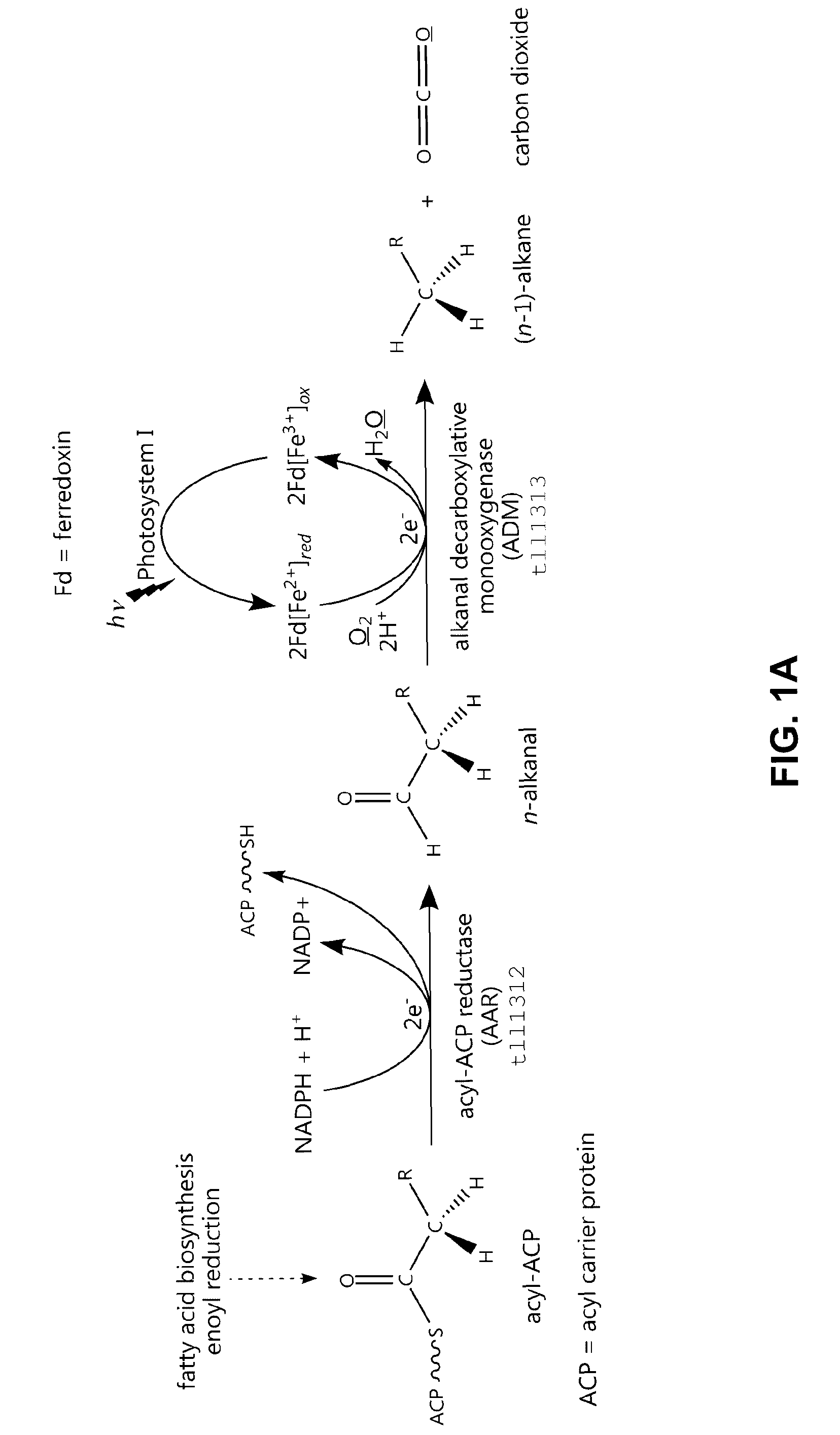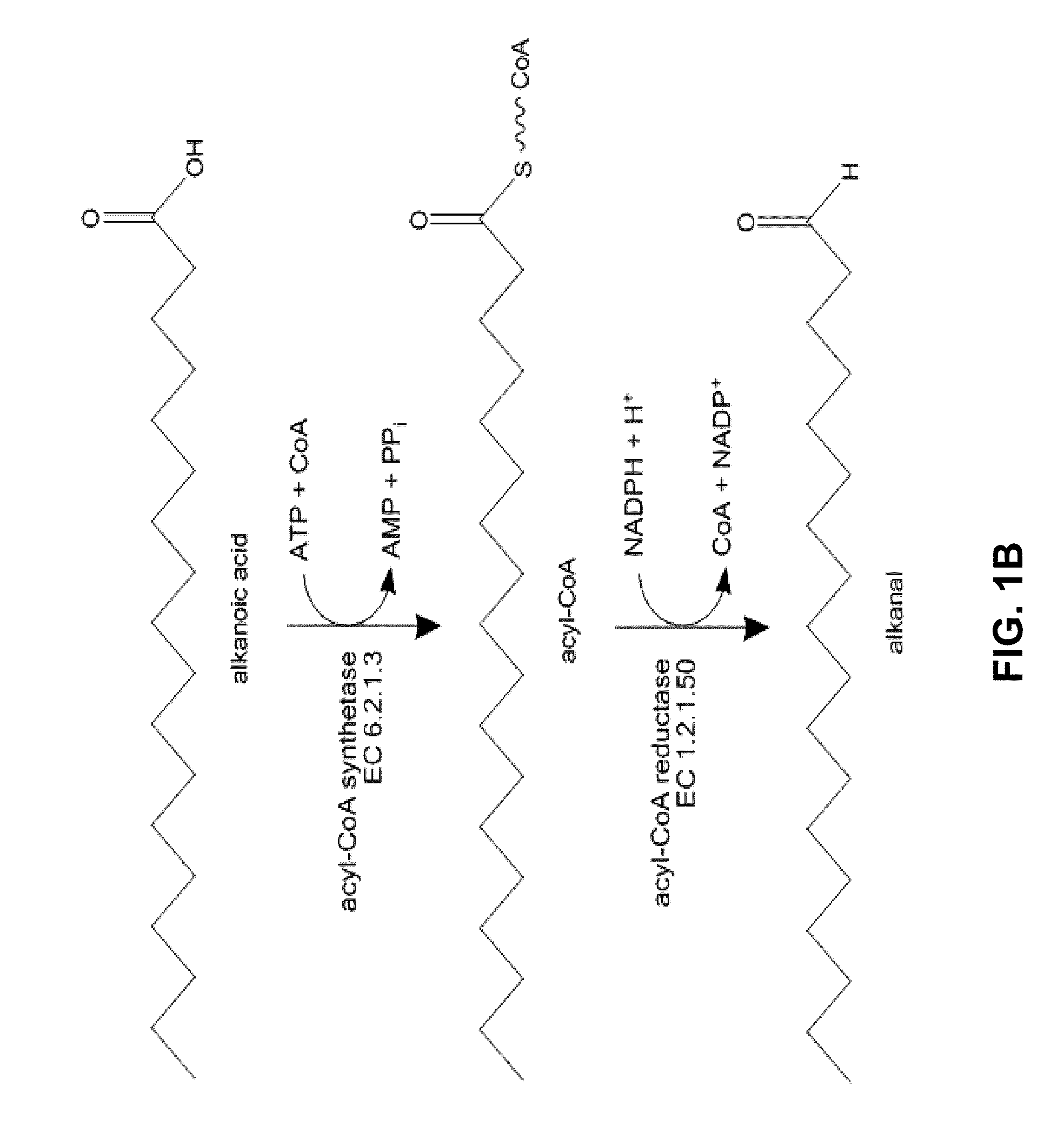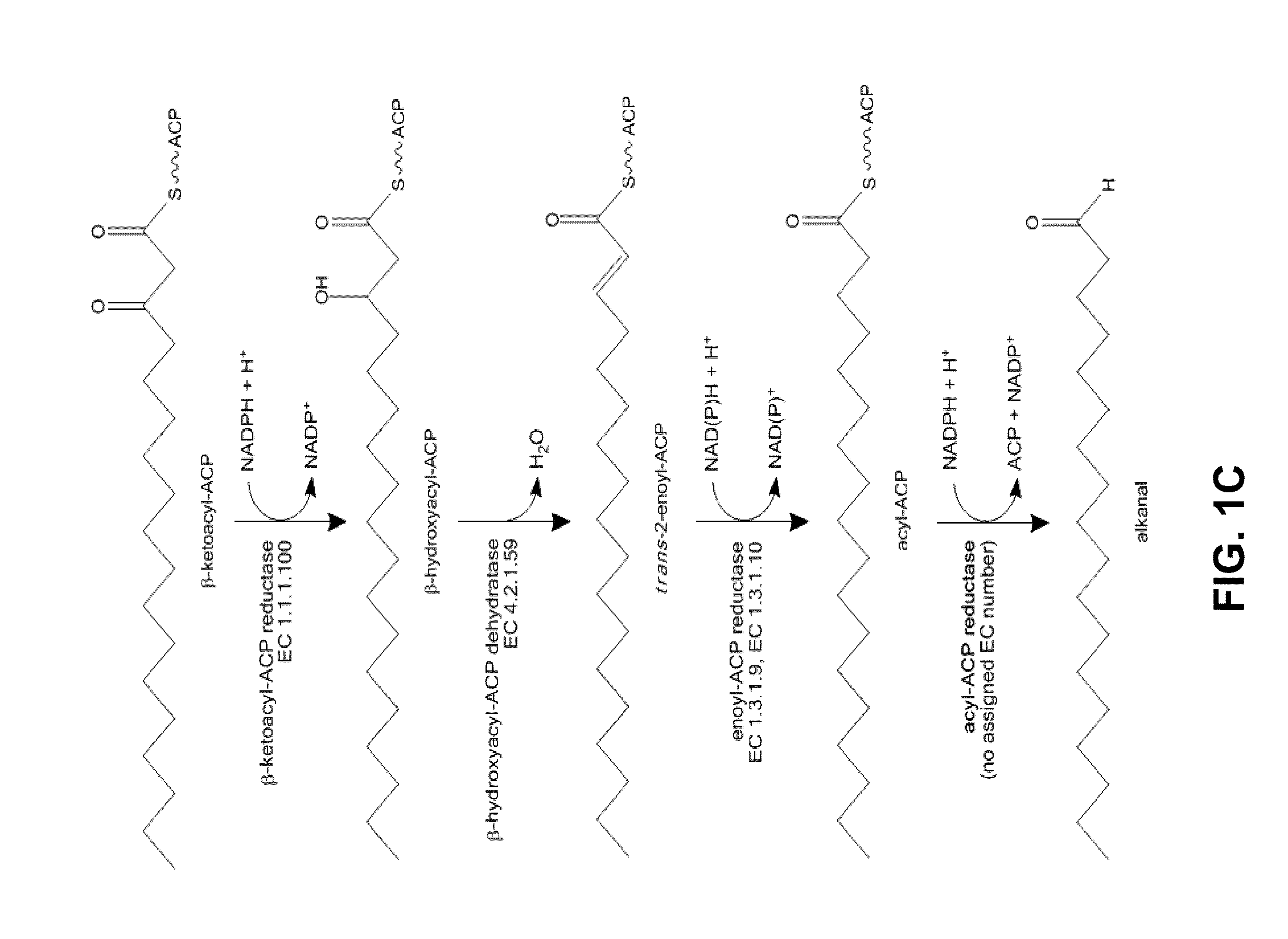Methods and compositions for the recombinant biosynthesis of n-alkanes
a technology of nalkane and biosynthesis, which is applied in the field of methods and compositions for the recombinant biosynthesis of nalkanes, can solve the problems of poorly suited industrial bioprocessing of photoautotrophic organisms, plants, algae, and photosynthetic bacteria, and achieve the effect of enhancing the capability of n-alkane production
- Summary
- Abstract
- Description
- Claims
- Application Information
AI Technical Summary
Benefits of technology
Problems solved by technology
Method used
Image
Examples
example 1
[0157]A pathway for the enzymatic synthesis of n-alkanes. An enzymatic process for the production of n-alkanes in, e.g., cyanobacteria is shown in FIG. 1A based on the sequential activity of (1) an AAR enzyme, e.g., tll1312, an acyl-ACP reductase; and (2) an ADM enzyme, e.g., tll1313, a putative alkanal decarboxylative monooxygenase, that uses reduced ferredoxin as electron donor. The AAR activity is distinct from the relatively well characterized acyl-CoA reductase activity exhibited by proteins such as Acr1 from Acinetobacter calcoaceticus (Reiser S and Somerville C (1997) J. Bacteriol. 179:2969-2975). A membranous ADM activity has previously been identified in insect microsomal preparations (Reed J R et al. (1994) Proc. Natl. Acad. Sci. USA 91:10000-10004; Reed J R et al. (1995) Musca domestica. Biochemistry 34:16221-16227).
[0158]FIGS. 1B and 1C summarize the names and activities of the enzymes involved in the biosynthesis of n-alkanals. FIG. 1B depicts the relatively well charac...
example 2
Production of n-Alkanes, n-Alkenes, and Fatty Alcohols in Escherichia coli K-12 through Heterologous Expression of Synechococcus elongatus PCC7942 SYNPCC7942—1593 (adm) and SYNPCC7942—1594 (aar)
[0175]The natural SYNPCC7942—1593-SYNPCC7942—1594 operonic sequence was PCR-amplified from the genomic DNA of Synechococcus elongatus PCC7942 and cloned into the pAQ1 homologous recombination vector pJB5 via NdeI and EcoRI. The resulting plasmid was denoted pJB823. This construct placed the SYNPCC7942—1593-SYNPCC7942—1594 operon under the transcriptional control of the constitutive aphII promoter. The sequence of pJB823 is provided as SEQ ID NO: 15. The intracellular hydrocarbon products of E. coli K-12 EPI400™ (Epicentre) harboring pJB823, JCC1076, were compared to those of EPI400™ harboring pJB5, the control strain JCC9a, by gas chromatography-mass spectrometry (GC-MS). Clonal cultures of JCC9a and JCC1076 were grown overnight at 37° C. in Luria Broth (LB) containing 2% glucose, 100 μg / ml c...
example 3
Production of n-Alkanes, n-Alkenes, and Fatty Alcohols in Escherichia coli B through Heterologous Expression of Synechococcus elongatus PCC7942 SYNPCC7942—1593 (adm) and SYNPCC7942—1594 (aar)
[0181]The natural SYNPCC7942—1593-SYNPCC7942—1594 operonic sequence was excised from pJB823 using NdeI and EcoRI, and cloned into the commercial expression vector pCDFDuet™-1 (Novagen) cut with via NdeI and Mfel. The resulting plasmid was denoted pJB855 (SEQ ID NO: 16). This construct placed the SYNPCC7942—1593-SYNPCC7942—1594 operon under the transcriptional control of the inducible T7lacO promoter.
[0182]The intracellular hydrocarbon products of E. coli BL21(DE3) (Novagen) harboring pJB855, JCC1113, were compared to those of E. coli BL21(DE3) harboring pCDFDuet™-1, the control strain JCC114, by gas chromatography-mass spectrometry (GC-MS). Starter clonal cultures of JCC1114 and JCC1113 were grown overnight at 37° C. in M9 minimal medium supplemented with 6 mg / l FeSO4.7H2O, 50 μg / ml spectinomyci...
PUM
| Property | Measurement | Unit |
|---|---|---|
| Fraction | aaaaa | aaaaa |
| Fraction | aaaaa | aaaaa |
| Fraction | aaaaa | aaaaa |
Abstract
Description
Claims
Application Information
 Login to View More
Login to View More - R&D
- Intellectual Property
- Life Sciences
- Materials
- Tech Scout
- Unparalleled Data Quality
- Higher Quality Content
- 60% Fewer Hallucinations
Browse by: Latest US Patents, China's latest patents, Technical Efficacy Thesaurus, Application Domain, Technology Topic, Popular Technical Reports.
© 2025 PatSnap. All rights reserved.Legal|Privacy policy|Modern Slavery Act Transparency Statement|Sitemap|About US| Contact US: help@patsnap.com



